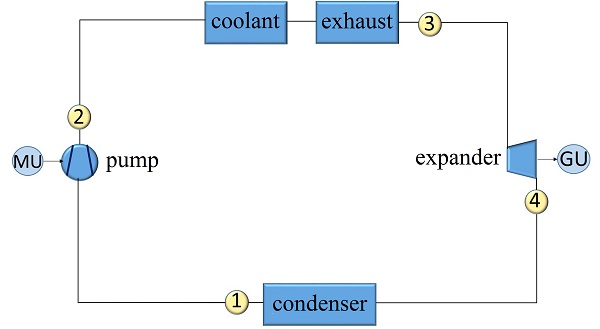Advanced Waste Heat Recovery Systems within Hybrid Powertrains
Keywords:
internal combustion engines, waste heat recovery systems, kinetic energy recovery systems, vehicle hybridizationAbstract
A waste heat recovery system (WHRS) is very well known to provide no advantage during the cold start driving cycles, such as the New European Driving Cycle (NEDC), which are used for certification of emissions and assessment of fuel economy. Here, we propose a novel integrated WHRS using the internal combustion engine (ICE) coolant passages and an exchanger on the exhaust working as pre-heater / boiler / super-heater of a Rankine cycle. The expander is connected to an electric generator unit (GU), and the pump is connected to an electric motor unit (MU). The vehicle is also fitted with an electric, kinetic energy recovery system (KERS). The expander and condenser are bypassed during the first part of the NEDC when the vehicle covers the four ECE-15 (Economic Commission for Europe - 15) - UDC (Urban Drive Cycle) segments where the engine warms-up. Only after the engine is fully warmed up, during the last part of the NEDC, the extra urban driving cycle (EUDC) segment, the expander and condenser are activated to recover part of the coolant and exhaust energy.
References
R. Freymann, W. Strobl, and A. Obieglo, “The turbo-steamer: a system introducing the principle of cogeneration in automotive applications,” MTZ worldwide, vol. 69, no. 5, pp. 404-412, May 2008.
A. Obieglo, J. Ringler, M. Seifert, and W. Hall, “Future efficient dynamics with heat recovery,” https://www1.eere.energy.gov/vehiclesandfuels/pdfs/deer_2009/session5/deer09_obieglo.pdf, 2009 (accessed October 15, 2015).
P. Tan, “BMW turbo-steamer,” http://paultan.org/2005/12/11/bmw-Turbo-Steamer/, 2005 (accessed October 15, 2015).
F. Will and A. Boretti, “A new method to warm up lubricating oil to improve the fuel efficiency during cold start,” SAE International Journal of Engines, vol. 4, no. 1, pp.175-187, April 2011.
J. Liu, J. Fu, Z. Xu, G. Zhu, and K. Feng, “An approach to recover IC engine exhaust gas energy based on Rankine steam cycle,” Advanced Science Letters, vol. 6, no. 1, pp. 706-710, March 2012.
A. Boretti, “Recovery of exhaust and coolant heat with R245fa organic Rankine cycles in a hybrid passenger car with a gasoline engine,” Applied Thermal Engineering, vol. 36, pp. 73-77, April 2012.
A. Boretti, “Energy recovery in passenger cars,” Journal of Energy Resources Technologies, vol. 134, no. 2, pp. 022203-1-022203-8, June 2012.
A. Boretti, “Transient operation of internal combustion engines with Rankine waste heat recovery systems,” Applied Thermal Engineering, vol. 48, pp. 18-23, December 2012.
T. A. Horst, H. S. Rottengruber, M. Seifert, and J. Ringler, “Dynamic heat exchanger model for performance prediction and control system design of automotive waste heat recovery systems,” Applied Energy, vol. 105, pp. 293-303, May 2012.
R. Capata and G. Hernandez, “Preliminary design and simulation of a turbo expander for small rated power organic Rankine cycle (ORC),” Energies, vol. 7, no.11, pp. 7067-7093, 2014.
L. Arnaud, G. Ludovic, D. Mouad, Z. Hamid, and L. Vincent, “Comparison and impact of waste heat recovery technologies on passenger car fuel consumption in a normalized driving cycle,” Energies, vol. 7, no. 8, pp. 5273-5290, August 2014.
T. A. Horst, W. Tegethoff, P. Eilts, and J. Koehler, “Prediction of dynamic Rankine Cycle waste heat recovery performance and fuel saving potential in passenger car applications considering interactions with vehicles' energy management,” Energy Conversion and Management, vol. 78, pp. 438-451, February 2014.
M. T. Musthafah, H. Safarudin, R. A. Bakar, M. A. Salim, and A. M. Mohd Shafie, “Feasibility study for energy recovery from internal combustion engine's waste heat,” International Review of Mechanical Engineering, vol. 8, no. 1, pp. 223-227, January 2014.
E. Massaguer, A. Massaguer, L. Montoro, and J. R. Gonzalez, “Modeling analysis of longitudinal thermoelectric energy harvester in low temperature waste heat recovery applications,” Applied Energy, vol. 140, pp. 184-195, February 2015.
P. Heidrich and T. Krisch, “Assessment of waste heat recovery options in passenger car applications by various Rankine Cycles,” Heat Transfer Engineering, vol. 36, no. 14-15, pp. 1321-1331, 2015.
S. G. Herawan, A. H. Rohhaizan, A. F. Ismail, S. A. Shamsudin, A. Putra, M. T. Musthafah, and A. R. Awang, “Prediction on power produced from power turbine as a waste heat recovery mechanism on naturally aspirated spark ignition engine using artificial neural network,” Modelling and Simulation in Engineering, vol. 2016, 2016 .
A. F. Agudelo, R. García-Contreras, J. R. Agudelo, and O. Armas, “Potential for exhaust gas energy recovery in a diesel passenger car under European driving cycle,” Applied Energy, vol. 174, pp. 201-212, July 2016.
A. Birch, “2016 Chevrolet Malibu hybrid exhaust gas heat recovery: feature spotlight,” http://gmauthority.com/blog/2015/04/2016-chevrolet-malibu-hybrid-exhaust-gas-heat-recovery-feature-spotlight/, 2015 (accessed October 15, 2015).
M. Petrány, “How formula one's amazing new hybrid turbo engine work,” http://jalopnik.com/how-formula-ones-amazing-new-hybrid-turbo-engine-works-1506450399, 2014 (accessed October 15, 2015).
Gamma Technologies LLC, “GT-SUITE overview,” https://www.gtisoft.com/gt-suite/gt-suite-overview/, 2015 (accessed October 15, 2015).
Gamma Technologies LLC, “GT-SUITE publications,” https://www.gtisoft.com/gt-suite/publications/, 2015 (accessed October 15, 2015).

Published
How to Cite
Issue
Section
License
Copyright (c) 2017 International Journal of Engineering and Technology Innovation

This work is licensed under a Creative Commons Attribution-NonCommercial 4.0 International License.
Copyright Notice
Submission of a manuscript implies: that the work described has not been published before that it is not under consideration for publication elsewhere; that if and when the manuscript is accepted for publication. Authors can retain copyright in their articles with no restrictions. Also, author can post the final, peer-reviewed manuscript version (postprint) to any repository or website.

Since Jan. 01, 2019, IJETI will publish new articles with Creative Commons Attribution Non-Commercial License, under Creative Commons Attribution Non-Commercial 4.0 International (CC BY-NC 4.0) License.
The Creative Commons Attribution Non-Commercial (CC-BY-NC) License permits use, distribution and reproduction in any medium, provided the original work is properly cited and is not used for commercial purposes.



.jpg)


